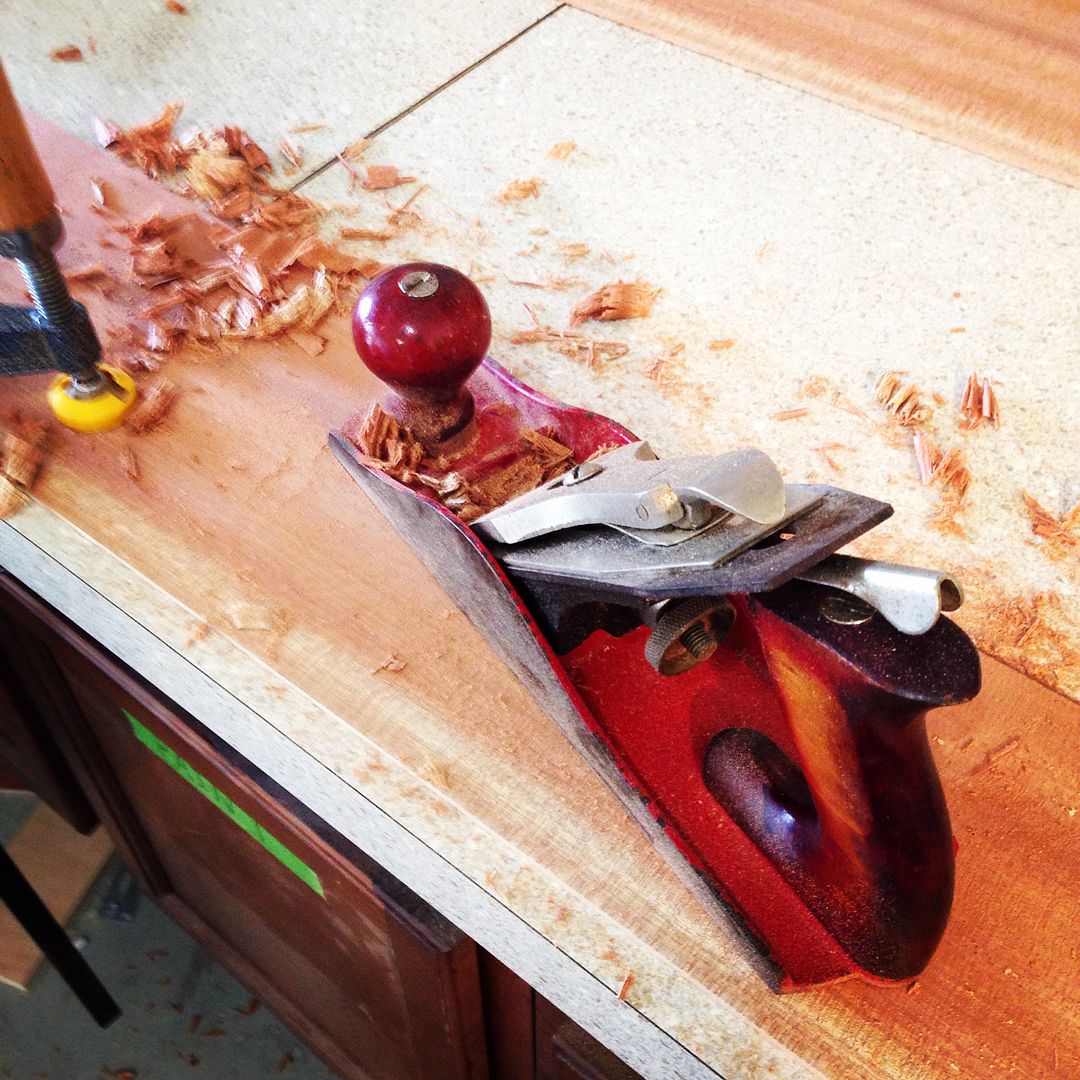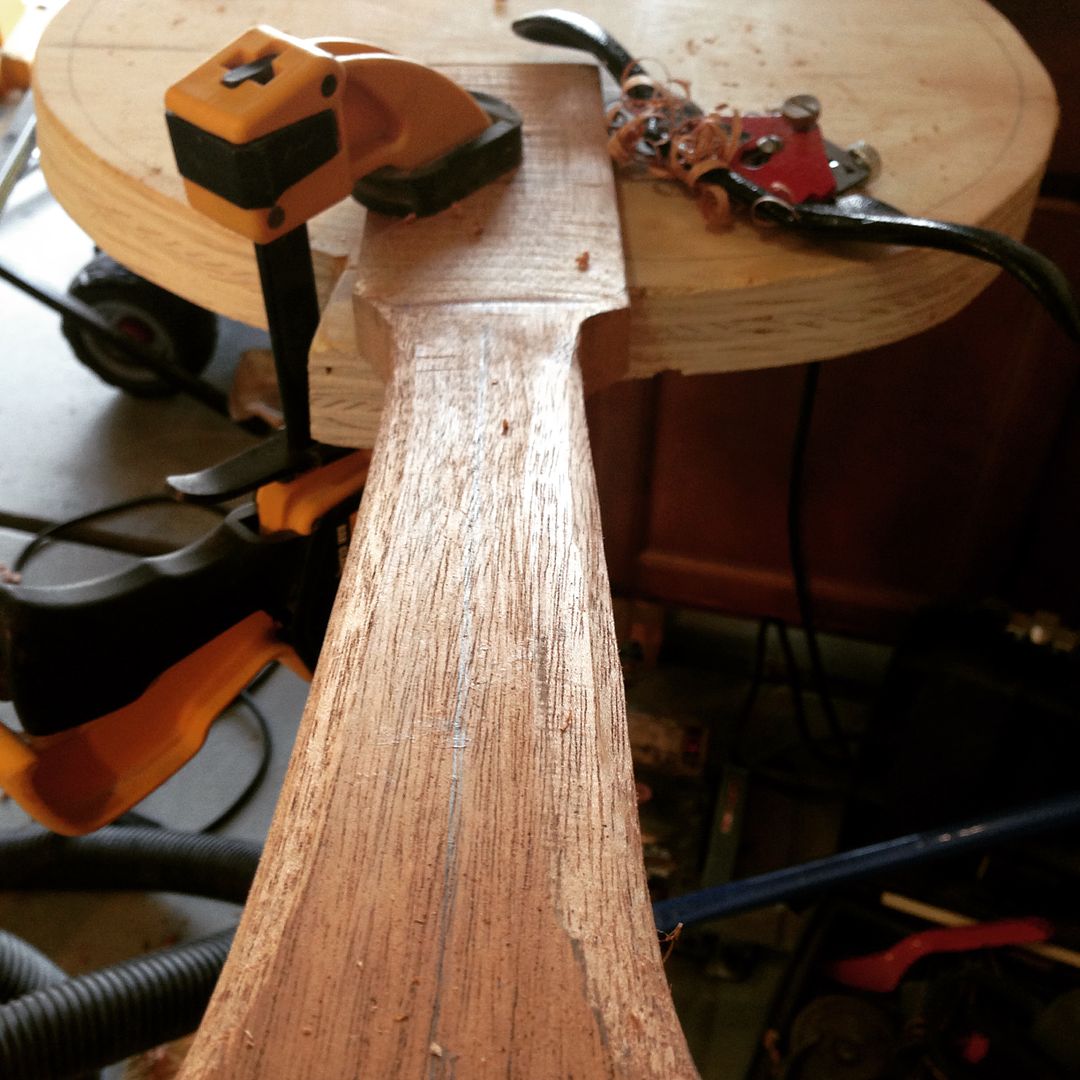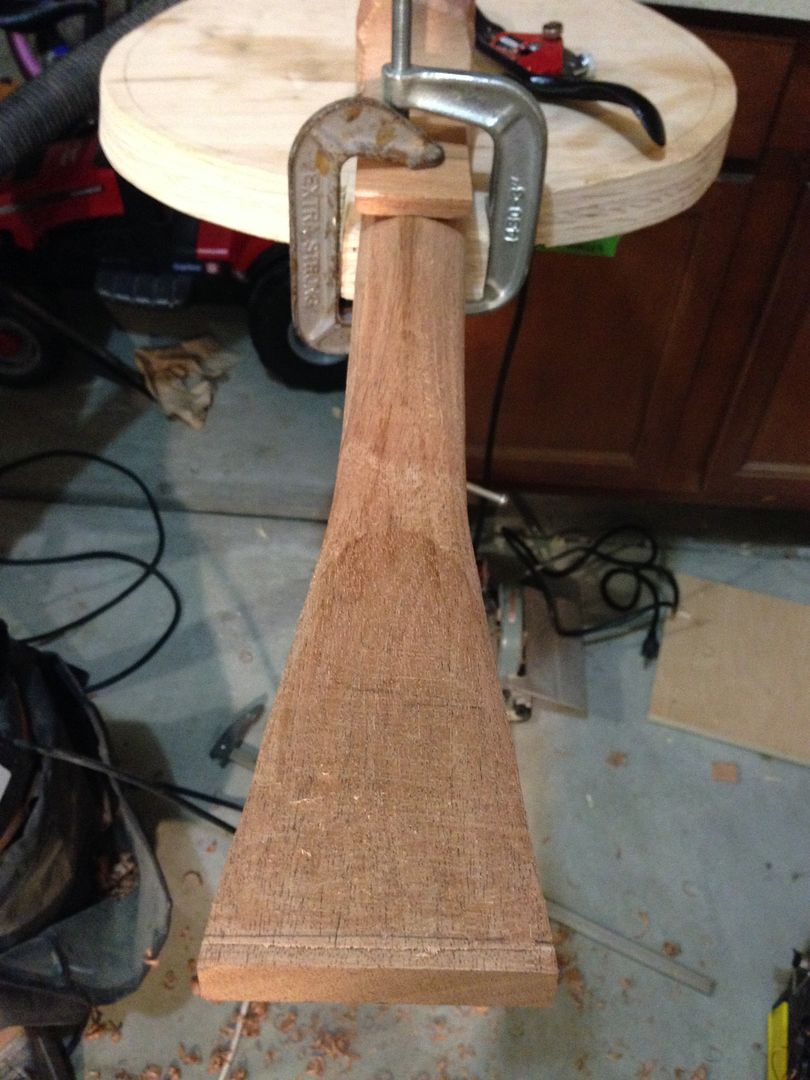
 |
|
#16
|
|||
|
|||
|
You're braver than me... I'm doing my first build with Mahogany and Sitka but NOT posting anything until it's complete.
 So far mine is going well - sides are bent and glued to tail/neck blocks, back is braced and ready to glue on, top bracing will happen over the next couple of days, and then on to the neck. I just need a suitable (and affordable) source for neck wood, either Honduras Mahogany, Sapele, Khaya, etc. but I want a piece big enough to not have to stack the heel. I don't mind a separate piece for the heel but don't want 3-4 pieces. Your build is looking good and I'm looking forward to seeing your progress. Keep up the good work!!
__________________
David My Woodworking YouTube channel - David Falkner Woodworking -------------------------------------------- Martin, Gallagher, Guild, Takamine, Falkner |
|
#17
|
|||
|
|||
|
David
I'm with ya! I hesitated for a long time, but realized that I could use the input of the folks on this forum to help. Can't wait to see your's when you're done!
__________________
Treenewt |
|
#18
|
|||
|
|||
|
Looks like you are off to a great start Treenewt. I remember you posting last year you wanted to try a build. I guarantee it will get easier after you get a couple under your belt.
Have you figured out how you are going to bend your sides? That was one of the build processes that scared me the most when I started. My first couple builds I bent on a pipe heated by a torch. It worked OK but I did have a learning curve with a couple of cracked sides. I made a bending jig and purchased a heat blanket and controller. Now bending sides is one of the easiest parts of the build and the sides don't have any ripples in them. Much easier to clean up later. Keep up the great work, we will all be rooting for you. Travis |
|
#19
|
|||
|
|||
|
Thanks Travis! Quite honestly, your builds encouraged me to get going! I am thinking of using a hot pipe as of now...but now you're scaring me! Ha! I gotta get those bad boys planed down first! Thanks for the advice!
__________________
Treenewt |
|
#20
|
|||
|
|||
|
Great choice of wood. One of the nicest-sounding guitars I've played recently was a Bourgeois Sitka/mahogany short scale 000.
|
|
#21
|
|||
|
|||
|
Today was the first Saturday in a month that I didn't have anything going on (until taking the kiddos out candy hunting) so, it being a nice day in central NC, me and my boy went out to piddle in the garage.
After making him a "plasma gun" out of some scrap (the boy loves all things boyish), I spent some time and tuned up my grandpas old bench plane. I got to work on thinning the sides.  Side note: I had so botched my original sides, I thought I was going to have to start over. I reached out to the builder I picked up my wood from last January, and turns out he had an odd set of sides left from the same board my original was cut from. He was kind enough to give them to me, I just had to cover shipping!! The grain is a spot on match! I also got the neck roughed out and spent some time shaping it a bit. This has to be my favorite thing I've done so far. Absolutely love seeing it take shape!  Super slow going, but I'm enjoying the ride!
__________________
Treenewt |
|
#22
|
|||
|
|||
|
I love that you've started this thread, as well as Guitar One! I've been wanting to build a guitar for many, many years and have done just about everything other than actually build something. I think I've been intimidated by the idea that I would discover that my abilities were so dismal as to . . . well, we've all had that nightmare.
Anyway, I've started guitar One as well! (Now that I've come out, so to speak, I'll have to finish it). I'm at the thicknessing stage as well, and it is going even slower than yours. but that's all good. So this thread is giving me a kick in the keister to go do something with my guitar wood. Yesterday I assembled a router table that I had picked up (get this) two years ago. Procrastinate much? Naaaahhh. Thanks again for the inspiration!
__________________
Taylor 815C '59 Gibson LG2 Washburn J4 jazz box, ebony tailpiece Gold Tone open back banjo Anon. mountain dulcimer Creaky old Framus 5/1 50 About 1/2 of Guitar One completed; currently intimidating me on account of the neck geometry. Stacks of mahogany, spruce, maritime rosewood, western red cedar Expensive sawdust |
|
#23
|
|||
|
|||
|
When Charles mentioned direction of the grain. He was not referring to whether you are going across the grain or with the grain. He was referring to which direction with the grain you are planing. The grain angles downward in one direction with the grain, and upward from the other direction. If you plain in the upward direction it will tear out. When grain has no run out it will be mostly flat, but it is rare to have absolutely no run out even on good tops so direction is important.
Just wanted to make sure that was clear. This is the reason curly figure is so difficult. It has run out in both directions. Having the steeper angle of the blade he mentioned helps with this problem. This can also be done with a bevel up plane by making a steeper bevel one the blade. This is something to look into if you plan on buying a plane. A bevel up plane is like owning three plans. You can change the purpose of the plane by changing the angle of the bevel. Three blades = Three different types of plane characteristics. A cost saver when purchasing tools. 25 degree = end grain 35 degree = straight grain 45-50 degree = curly or figured wood Combined with an adjustable throat it covers pretty much all you need. I prefer a bench plane for straight grain, but a bevel up equally gets it done. I have a 91/2" block that works as a smoother in a pinch on curly or otherwise difficult grain, but I also use a 15" bevel up jack. You can get carried away buying planes, but having a #4, #5, and #6 bench with the other two make can make things go real smooth. If I could only have three. They would be the bevel up jack, the bevel up block, and the #4 bench all with an adjustable throat. |
|
#24
|
|||
|
|||
|
Quote:
. |
|
#25
|
|||
|
|||
|
Quote:
__________________
Treenewt |
|
#26
|
|||
|
|||
|
Duplicate post
__________________
Treenewt |
|
#27
|
|||
|
|||
|
Quote:
__________________
Treenewt |
|
#28
|
|||
|
|||
|
I spent a little time this afternoon working on the neck and headstock some more. I have to say, this definitely gets my vote for most enjoyable part of the build so far. My little Stanley spokeshave has done a fine job on the Khaya, taking off nice shavings with each pass.
It is very cool to shave away and to see the curve coming into being. I haven't taken it fully down yet, as I'm torn between a modern C shape and a more vintage V. I'd work a little bit, undo the clamps, and hold it in my hand to get an idea for the feel...it's shaping up! I also trimmed up the headstock. I went with a Martin-Esque squared off look. Here's a quick shot: 
__________________
Treenewt |
|
#29
|
|||
|
|||
|
You're doomed, you know. It starts like this and ends up with you buying a sawmill so you can cut your own wood.
I'm trying to resist the compulsion to build a 000-12 fret out of wood found here on the ranch as I type this. The good thing is, when you get to the point that you're thinking about building an addition on the house so you'll have room for your guitars, you can start giving the excess instruments to people. They'll love you for it. But it's definitely an addiction. Building guitars is the woodworking equivalent of heroin. You'll swear it off a million times, but that pull will always be there. You'll wake up in the night thinking things like, "What would a Peruvian Walnut with Redwood top L-00 sound like?" 
|
|
#30
|
|||
|
|||
|
Quote:
Regarding grain and direction of planing: 1) Yes, if there is significant grain run out, then planing in the same direction of the run-out, rather than into the run-out, is the best idea. And cutting into the run-out is usually folly. 2) That said, there is more to it. Planing faces of wood can yield better results if the plane ORIENTATION is held non-parallel with the lengthwise direction of the grain. Also, it can be beneficial if the STROKE of the plane is made somewhat diagonal to the direction of the grain length. Experimenting with slight variations of STROKE and ORIENTATION angle can yield good results. You should be able to find an orientation that will yield minimal to no tear-out. Mahogany tends to have winding grain, so if you cut with a straight orientation and stroke you will likely always be cutting into the grain run out at some spots in the wood.
__________________
---- Ned Milburn NSDCC Master Artisan Dartmouth, Nova Scotia |